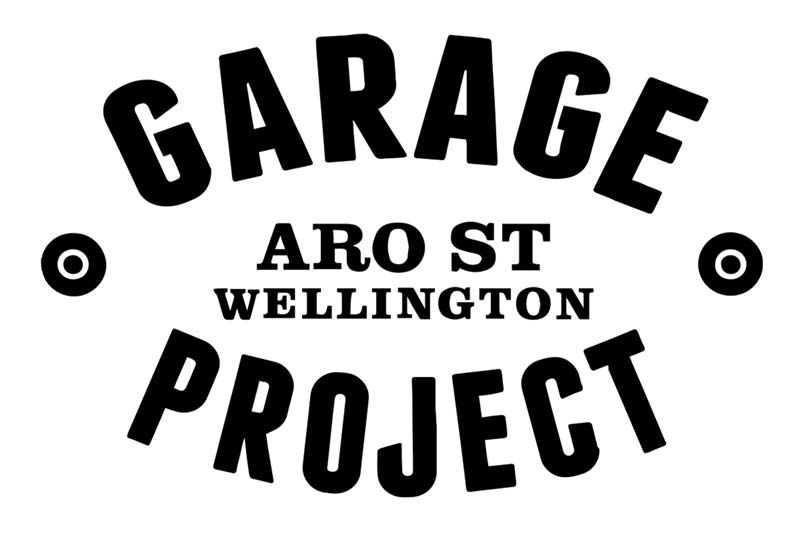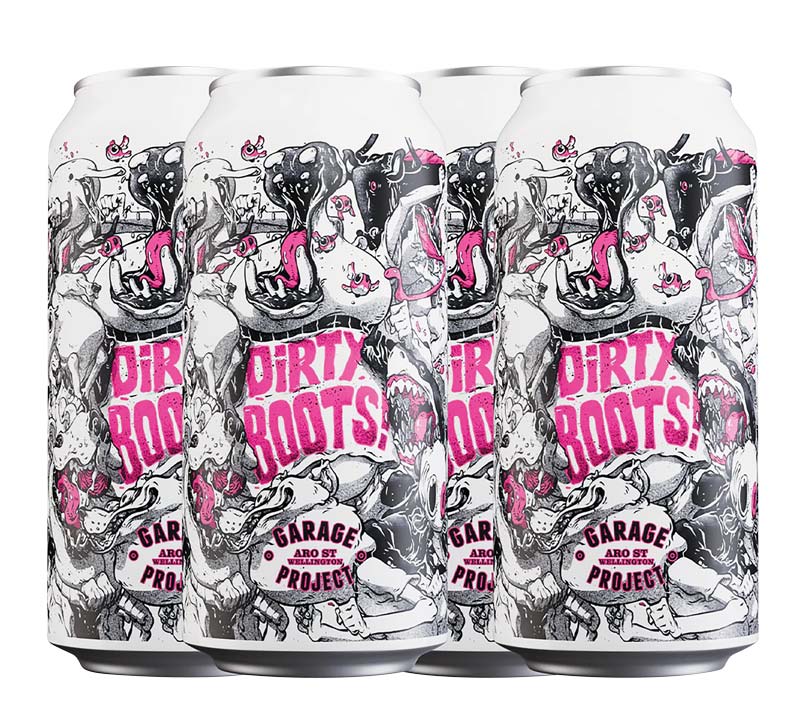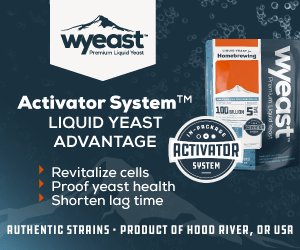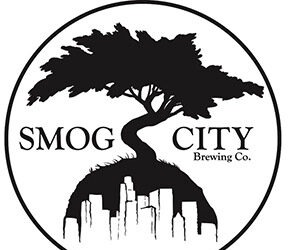Garage Project Brewery
Dear Replicator,
In a world full of hazy beers, Garage Project’s Dirty Boots is a throwback to old-school, hoppy American-style pale ales with newer-school hops and an old-school malt backbone, brewed by one of New Zealand’s best craft breweries. Dirty by name, clean in flavor; described as “grunge inspired” and “beer to brew to,” I can’t wait for this one! Replicator, if you can bring together a homebrew recipe for this beer, I would greatly appreciate it. Thanks!
Jimmy Katsiouras
Auckland, New Zealand
Founded just over 12 years ago by Pete Gillespie and Jos Ruffell, with help from Pete’s brother Ian, Garage Project began as so many others do in a nascent industry: Small and experimental. Brewing on a 50-liter pilot system (about 13 U.S. gallons), the brewery kicked off with what they called the 24/24, an ambitious project for releasing a brand new beer every week over a span of six months.
“When you’re brewing on such a small scale you can afford to take risks, which was important to us,” says Gillespie. “To be honest, between our FRESH (hazy IPA) monthly drops, limited releases, and Wild Workshop (the brewery’s spontaneous, mixed fermentation, and barrel-aged sour program) beers we’re still releasing far more than one new beer a week on average. So, we still love taking risks and trying something new.”
Located in New Zealand, home to some of the world’s best hop growing regions, Garage Project knew from the start that they were fortunate to have access to such significant agricultural resources. With a brewery inclined toward experimentation, Garage Project has released almost 700 beers to date — brewing a plethora of IPAs and pale ales with various hop configurations was an opportunity they couldn’t resist.

“The New Zealand hop growing scene is probably what excites us the most,” says Gillespie. “Hop quality here has improved greatly over the years as farmers focus on growing, harvesting, and processing the best aroma and flavor varieties. We’ve also got new farms outside the traditional New Zealand hop growing region, as far afield as Nelson Lakes and even Southland producing hops with their own unique terroir characters. For any brewer, it’s like being a kid in a candy store.”
Dirty Boots pale ale is what the brewery describes as a “full noise” pale ale bordering on an IPA, with assertive bitterness backed up by malt character from a grain bill of Pilsner, crystal, and Munich malt. The brewery felt that the Simcoe® and Mosaic® hop pairing is near ideal, with what seems like a classic, but still verging on modern take of hops for American-style pale ales and IPAs. Ekuanot® hops, meanwhile, provided an avenue for experimentation.
“Ekuanot® at the time was a relatively new hop and we were keen to try it out,” Gillespie says. “Its flavor and aroma characteristics are described as bubblegum, citrus, stone fruit, tropical, and woody, notes that we felt would be perfect companions to the citrus and dank tropical notes of Simcoe® and Mosaic®.”
When it comes to pale ale, most brewers consider drinkability and balance to be keys to the style. According to Low, to ensure that Dirty Boots continued to push boundaries — as fans of Garage Project have come to expect — the brewers knew that they needed to “turn up the volume on every aspect of the beer” while keeping the core elements of malt, hops, alcohol, and bitterness aligned for an overall well-balanced recipe.
“While it’s no longer as glamorous as many of the newer, more in your face styles, pale ale was the gateway for many beer fans’ journeys into full-flavored beer in the early days of craft,” Gillespie says. “Many drinkers come back to it and rediscover the joy of malt-hop balance and drinkability while still enjoying flavor.”
To achieve a marriage of classic techniques with a blend of distinctly modern hops, Garage Project called upon a tried-and-true brewing technique: Staggered, regular hop additions throughout the boil. While many modern IPAs — particularly those of the hazy variety — confine their hotside hop additions almost exclusively to the whirlpool and dry hop, Low said that he feels there are still circumstances where multiple hop additions throughout the boil can create layers and depth of hop flavor that can’t be achieved by whirlpool and dry hop additions alone.
“Don’t be afraid to experiment with process, but make notes, taste your beers critically, and learn what works and what doesn’t in every given situation,” Gillespie says. “Find processes that work for your brewhouse and the beers you are trying to brew. There is no one answer to this, and that’s why there are so many great breweries out there making diverse but incredible beer. For instance, we treat certain hop varieties differently in dry hop for timing and contact time and certain varieties we find perform better hot side versus dry hop. So, on that note, you can never fully divorce recipe from process. Both interact and will inform each other when designing a great beer.”
“These kinds of West Coast pale ales and IPAs have perhaps been overshadowed in recent years by the haze craze, but all it takes is to come back to one of these classics and you remember what made them so popular,” says Gillespie. “They’re just such great beers.”
Garage Project’s Dirty Boots Pale Ale clone

(5 gallons/19 L, all-grain)
OG = 1.063 FG = 1.013
IBU = 75 SRM = 9 ABV = 6.6%
Ingredients
10 lbs. (4.5 kg) Pilsner malt
1.7 lbs. (0.77 kg) Munich malt (9 °L)
0.8 lb. (0.36 kg) crystal malt (20 °L)
0.5 lb. (0.23 kg) crystal malt (60 °L)
6.5 AAU Simcoe® hops (first wort hop) (0.5 oz./14 g at 13% alpha acids)
7.5 AAU Ekuanot® hops (10 min.) (0.5 oz./14 g at 15% alpha acids)
6 AAU Mosaic® hops (10 min.) (0.5 oz./14 g at 12% alpha acids)
6.5 AAU Simcoe® hops (10 min.) (0.5 oz./14 g at 13% alpha acids)
6 AAU Mosaic® hops (0 min.) (0.5 oz./14 g at 12% alpha acids)
2 oz. (57 g) Ekuanot® hops (dry hop)
2 oz. (57 g) Mosaic® hops (dry hop)
2 oz. (57 g) Simcoe® hops (dry hop)
SafAle US-05, White Labs WLP001 (California Ale), Wyeast 1056 (American Ale), or similar American ale yeast strain
3⁄4 cup corn sugar (if priming)
Step by Step
With the goal of creating a moderately dextrinous wort, mash in with 4 gallons (15.4 L) of 165 °F (74 °C) strike water to achieve a single infusion rest temperature of 154 °F (68 °C). Hold at this temperature for 60 minutes before starting the lautering process.
Add first wort hops to the boil kettle. With sparge water at 170 °F (77 °C), collect about 6.5 gallons (25 L) total of wort. Boil for 60 minutes, adding hops at intervals according to hop schedule. At end of boil, turn off heat then add the whirlpool addition hops. Whirlpool for 10 minutes, then let settle for 10 minutes before chilling wort.
Chill wort to slightly below fermentation temperature, around 66 °F (19 °C). Pitch yeast. Ferment at 68 °F (20 °C), raising temperature to 72 °F (22 °C) as fermentation slows down.
After fermentation has ceased and settling has occurred, add dry hops and allow 3 days contact before packaging. Prime and bottle condition or keg and force carbonate to 2.4 v/v.
Garage Project’s Dirty Boots Pale Ale Clone
(5 gallons/19 L, extract with grains)
OG = 1.063 FG = 1.013
IBU = 75 SRM = 9 ABV = 6.6%
Ingredients
6 lbs. (2.7 kg) Pilsen dried malt extract
0.75 lb. (0.34 kg) Munich dried malt extract
0.8 lb. (0.36 kg) crystal malt (20 °L)
0.5 lb. (0.23 kg) crystal malt (60 °L)
6.5 AAU Simcoe® hops (first wort hop) (0.5 oz./14 g at 13% alpha acids)
7.5 AAU Ekuanot® hops (10 min.) (0.5 oz./14 g at 15% alpha acids)
6 AAU Mosaic® hops (10 min.) (0.5 oz./14 g at 12% alpha acids)
6.5 AAU Simcoe® hops (10 min.) (0.5 oz./14 g at 13% alpha acids)
6 AAU Mosaic® hops (0 min.) (0.5 oz./14 g at 12% alpha acids)
2 oz. (57 g) Ekuanot® hops (dry hop)
2 oz. (57 g) Mosaic® hops (dry hop)
2 oz. (57 g) Simcoe® hops (dry hop)
SafAle US-05, White Labs WLP001 (California Ale), Wyeast 1056 (American Ale), or similar American ale yeast strain
3⁄4 cup corn sugar (if priming)
Step by Step
Steep crushed grains in a muslin bag in 2 gallons (8 L) of water as temperature warms to 160 °F
(71 °C) over 30 minutes. Afterwards, place the grain bag in a colander and wash with 1 gallon (4 L) of warm or hot water. Add first wort hops and water to reach a total volume of 6 gallons (23 L). With the heat turned off, carefully stir in the dried malt extract. Once fully dissolved, bring wort to a boil and boil for 60 minutes, adding hops at intervals according to hop schedule.
At end of boil, add whirlpool addition hops. Whirlpool for 10 minutes, then let settle for 10 minutes before chilling wort.
Chill wort to slightly below fermentation temperature, around 66 °F (19 °C). Pitch yeast. Ferment at 68 °F (20 °C), raising temperature to 72 °F (22 °C) as fermentation slows down.
After fermentation has ceased and settling has occurred, add dry hops and allow 3 days contact before packaging. Prime and bottle condition or keg and force carbonate to 2.4 v/v.



